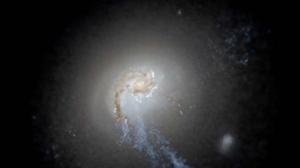Supernova Bubbles In The Milky Way Could Be Launching Stars Into Its Outer Halo

From simulations, researchers saw that young blue stars formed by accelerated and compressed gas from clusters of supernova explosions were blown radially outward.
Researchers from America have simulated what the aftermath of a cluster of supernova explosions may look like in Milky Way-mass galaxies, and the results do not disappoint. The immense energy accelerates high-density gas outwards from the galaxy center. As the gas compresses at the edges of these “super bubbles”, new stars are formed, which continue to be propelled into the outer-regions of the stellar halo. This star-forming mechanism could account for up to 40 percent of stars found in galactic outer-halos, upending commonly held notions of the formation and evolution of star systems.
“The FIRE-2 [Feedback in Realistic Environments 2] simulations allow us to generate movies that make it seem as though you’re observing a real galaxy,” Sijie Yu, lead author and PhD candidate from the University of California, Irvine (UCI), said in a statement. “They show us that as the galaxy center is rotating, a bubble driven by supernova feedback is developing with stars forming at its edge. It looks as though the stars are being kicked out from the center."

This mock Hubble Space Telescope image shows how supernova bubbles catapult the young blue stars outwards. The pink areas show the stellar birth region, and the red/brown areas are where dust has obscured the starlight. Sije Yu/ UCI
Galactic stellar halos, the large, roughly spherical region surrounding the main disk of a galaxy, provide astronomers with clues as to the history of these cosmic structures, which can sometimes prove quite turbulent. Most of the stellar halo is predominantly thought to contain stars formed in smaller galaxies and subsequently accreted by the parent galaxy over lengthy periods of time. Yet the method proposed by the team in Monthly Notices of the Royal Astronomical Society suggests a non-negligible fraction of the halo comes from a different source: “supernova feedback.”
In six high-resolution simulations, Yu and colleagues discovered that between 5 and 40 percent of the outer stellar halo (50-300kpc from the galactic center) in their Milky Way-like galaxies were born from the supernova bubble outflows. Over the course of the galaxies' lifetime, this mechanism could account for roughly 2 percent of all stars. But during booming starburst periods in the galaxy’s past, as many as 20 percent of stars at the time formed this way.
“There are some current projects looking at galaxies that are considered to be very ‘starbursting’ right now,” Yu said. “Some of the stars in these observations also look suspiciously like they’re getting ejected from the center.”
How else can we distinguish the super bubble produced stars from others in the halo? As the paper explains, these outflow stars are more smoothly distributed, more metal-rich and are alpha element-enhanced (elements generated from fusion processes that convert helium into heavier elements), than the typically old and metal-poor accreted stars in the stellar halo. Therefore, by looking at the chemical and spatial characteristics of stars, astronomers can determine the potential abundance of outflow stars in our own galaxy, not just using simulations.
“In plots that compare data from the European Space Agency’s Gaia mission – which provides a 3D velocity chart of stars in the Milky Way – with other maps that show stellar density and metallicity, we can see structures similar to those produced by outflow stars in our simulations,” Yu explained.
“These highly accurate numerical simulations have shown us that it’s likely the Milky Way has been launching stars in circumgalactic space in outflows triggered by supernova explosions,” James Bullock, senior author and professor of physics and astronomy at UCI concluded.
